Understanding Hydrological Responses to Land Use and Land Cover Change in the Belize River Watershed
Abstract
1. Introduction
- Calibrate and improve the accuracy of the SWAT model using in situ streamflow measurements and the SWAT Calibration and Uncertainty Programs (SWAT-CUP);
- Investigate the predominant land use and land cover patterns replacing forests in the BRW;
- Examine the changes in simulated hydrological responses at the watershed and subwatershed levels between three annual land cover datasets, (i.e., 2000, 2010, and 2020) and an alternative 2020 land cover scenario replacing agricultural lands in protected areas with evergreen forests.
2. Materials and Methods
2.1. Study Area
2.2. The SWAT Model
2.3. Data Acquisition and Preprocessing
2.3.1. Elevation Data and Stream Network
2.3.2. Soil Data
2.3.3. Land Cover and Protected Areas Data
2.3.4. Meteorological Data
2.3.5. Hydrological Data
2.4. SWAT Model Setup
2.5. Model Calibration and Validation
2.6. Spatial Analysis of LULCCs Leading to Forest Cover Loss
2.7. Analysis of Modeled Results
- The sub-basin with the most absolute change in forest cover area from LC2000 to LC2020. This sub-basin was selected to identify the hydrological impacts of forest cover loss on the watershed region experiencing the most deforestation;
- The sub-basin with the most relative change in forest cover area from LC2000 to LC2020. This sub-basin was selected to quantify the magnitude of localized hydrological impacts resulting from forest cover loss;
- The sub-basin with the most relative change in forest cover areas from LC2020 to LC2020PA. This sub-basin was selected to understand the degree to which reforestation of agricultural encroachments in protected areas can alter local watershed hydrology.
3. Results and Discussion
3.1. Model Performance and Evaluation
3.2. Trends in LULCC
3.2.1. Watershed-Level Trends
3.2.2. Case Study One: Sub-Basin with the Most Absolute Forest Change
3.2.3. Case Study Two: Sub-Basin with the Most Relative Forest Change
3.2.4. Case Study Three: Sub-Basin with the Most Relative Forest Change in LC2020PA
3.3. Hydrological Responses to LULCC
3.3.1. Watershed-Level Responses
3.3.2. Case Study Responses
4. Conclusions
Author Contributions
Funding
Data Availability Statement
Acknowledgments
Conflicts of Interest
Abbreviations
| LULCC | Land use and land cover change |
| ET | Evapotranspiration |
| SWAT | Soil and Water Assessment Tool |
| BRW | Belize River Watershed |
| N-SPECT | Non-Point Source Pollution and Erosion Comparison Tool |
| HRU | Hydrological response unit |
| PSO | Particle SWAT Organization |
| SPE | SWAT Parameter Estimator |
| SUFI-2 | SWAT-CUP Sequential Uncertainty Fitting |
| 95PPU | 95% Confidence Interval |
| DEM | Digital elevation model |
| SRTM | Shuttle Radar Topography Mission |
| USGS | United States Geological Survey |
| HWSD | Harmonized World Soil Database |
| FAO | Food and Agriculture Organization of the United Nations |
| ESA | European Space Agency |
| CCI | Climate Change Initiative |
| NMSB | National Meteorological Service of Belize |
| CHIRPS | Climate Hazards Group Infrared Precipitation with Stations |
| CHIRTS-daily | Climate Hazards Group Infrared Temperature with Stations |
| NSRDB | National Solar Radiation Database |
| WGEN | SWAT Weather Generator |
| DR | Double Run |
| BV | Benque Viejo |
| NHSB | National Hydrological Service of Belize |
| BERDS | Biodiversity and Environmental Resource Data System of Belize |
| PET | Potential evapotranspiration |
| Coefficient of determination | |
| Nash–Sutcliffe efficiency | |
| Percent bias | |
| GEOGLOWS | Group on Earth Observations Global Water Sustainability |
References
- Garg, V.; Nikam, B.R.; Thakur, P.K.; Aggarwal, S.P.; Gupta, P.K.; Srivastav, S.K. Human-Induced Land Use Land Cover Change and Its Impact on Hydrology. HydroResearch 2019, 1, 48–56. [Google Scholar] [CrossRef]
- Hassan, Z.; Shabbir, R.; Ahmad, S.S.; Malik, A.H.; Aziz, N.; Butt, A.; Erum, S. Dynamics of Land Use and Land Cover Change (LULCC) Using Geospatial Techniques: A Case Study of Islamabad Pakistan. SpringerPlus 2016, 5, 812. [Google Scholar] [CrossRef] [PubMed]
- Lambin, E.F.; Turner, B.L.; Geist, H.J.; Agbola, S.B.; Angelsen, A.; Bruce, J.W.; Coomes, O.T.; Dirzo, R.; Fischer, G.; Folke, C.; et al. The Causes of Land-Use and Land-Cover Change: Moving Beyond the Myths. Glob. Environ. Change 2001, 11, 261–269. [Google Scholar] [CrossRef]
- Curtis, P.G.; Slay, C.M.; Harris, N.L.; Tyukavina, A.; Hansen, M.C. Classifying Drivers of Global Forest Loss. Science 2018, 361, 1108–1111. [Google Scholar] [CrossRef]
- Kroeger, T.; Klemz, C.; Boucher, T.; Fisher, J.R.B.; Acosta, E.; Cavassani, A.T.; Dennedy-Frank, P.J.; Garbossa, L.; Blainski, E.; Santos, R.C.; et al. Returns on Investment in Watershed Conservation: Application of a Best Practices Analytical Framework to the Rio Camboriú Water Producer Program, Santa Catarina, Brazil. Sci. Total Environ. 2019, 657, 1368–1381. [Google Scholar] [CrossRef]
- de Mello, K.; Taniwaki, R.H.; de Paula, F.R.; Valente, R.A.; Randhir, T.O.; Macedo, D.R.; Leal, C.G.; Rodrigues, C.B.; Hughes, R.M. Multiscale Land Use Impacts on Water Quality: Assessment, Planning, and Future Perspectives in Brazil. J. Environ. Manag. 2020, 270, 110879. [Google Scholar] [CrossRef]
- Taffarello, D.; Srinivasan, R.; Mohor, G.S.; Guimarães, J.L.B.; do Carmo Calijuri, M.; Mendiondo, E.M. Modeling Freshwater Quality Scenarios with Ecosystem-Based Adaptation in the Headwaters of the Cantareira System, Brazil. Hydrol. Earth Syst. Sci. 2018, 22, 4699–4723. [Google Scholar] [CrossRef]
- Anache, J.A.A.; Wendland, E.C.; Oliveira, P.T.S.; Flanagan, D.C.; Nearing, M.A. Runoff and Soil Erosion Plot-Scale Studies under Natural Rainfall: A Meta-Analysis of the Brazilian Experience. Catena 2017, 152, 29–39. [Google Scholar] [CrossRef]
- Bruijnzeel, L.A. Hydrological Functions of Tropical Forests: Not Seeing the Soil for the Trees? Agric. Ecosyst. Environ. 2004, 104, 185–228. [Google Scholar] [CrossRef]
- Costanza, R.; d’Arge, R.; de Groot, R.; Farber, S.; Grasso, M.; Hannon, B.; Limburg, K.; Naeem, S.; O’Neill, R.V.; Paruelo, J.; et al. The Value of the World’s Ecosystem Services and Natural Capital. Nature 1997, 387, 253–260. [Google Scholar] [CrossRef]
- Esen, S.E.; Hein, L.; Cuceloglu, G. Accounting for the Water Related Ecosystem Services of Forests in the Southern Aegean Region of Turkey. Ecol. Indic. 2023, 154, 110553. [Google Scholar] [CrossRef]
- Krishnaswamy, J.; Bonell, M.; Venkatesh, B.; Purandara, B.K.; Rakesh, K.N.; Lele, S.; Kiran, M.C.; Reddy, V.; Badiger, S. The Groundwater Recharge Response and Hydrologic Services of Tropical Humid Forest Ecosystems to Use and Reforestation: Support for the “Infiltration-Evapotranspiration Trade-off Hypothesis”. J. Hydrol. 2013, 498, 191–209. [Google Scholar] [CrossRef]
- Brookhuis, B.J.; Hein, L.G. The Value of the Flood Control Service of Tropical Forests: A Case Study for Trinidad. For. Policy Econ. 2016, 62, 118–124. [Google Scholar] [CrossRef]
- Menéndez, P.; Losada, I.J.; Torres-Ortega, S.; Narayan, S.; Beck, M.W. The Global Flood Protection Benefits of Mangroves. Sci. Rep. 2020, 10, 4404. [Google Scholar] [CrossRef]
- Gordon, L.J.; Steffen, W.; Jönsson, B.F.; Folke, C.; Falkenmark, M.; Johannessen, Å. Human Modification of Global Water Vapor Flows from the Land Surface. Proc. Natl. Acad. Sci. USA 2005, 102, 7612–7617. [Google Scholar] [CrossRef]
- Scanlon, B.R.; Jolly, I.; Sophocleous, M.; Zhang, L. Global Impacts of Conversions from Natural to Agricultural Ecosystems on Water Resources: Quantity versus Quality. Water Resour. Res. 2007, 43, W03437. [Google Scholar] [CrossRef]
- Akinnawo, S.O. Eutrophication: Causes, Consequences, Physical, Chemical and Biological Techniques for Mitigation Strategies. Environ. Chall. 2023, 12, 100733. [Google Scholar] [CrossRef]
- Owens, P.N. Soil Erosion and Sediment Dynamics in the Anthropocene: A Review of Human Impacts during a Period of Rapid Global Environmental Change. J. Soils Sediments 2020, 20, 4115–4143. [Google Scholar] [CrossRef]
- Rápalo, L.M.C.; Uliana, E.M.; Moreira, M.C.; da Silva, D.D.; de Melo Ribeiro, C.B.; da Cruz, I.F.; dos Reis Pereira, D. Effects of Land-Use and -Cover Changes on Streamflow Regime in the Brazilian Savannah. J. Hydrol. Reg. Stud. 2021, 38, 100934. [Google Scholar] [CrossRef]
- Sadhwani, K.; Eldho, T.I.; Jha, M.K.; Karmakar, S. Effects of Dynamic Land Use/Land Cover Change on Flow and Sediment Yield in a Monsoon-Dominated Tropical Watershed. Water 2022, 14, 3666. [Google Scholar] [CrossRef]
- Ware, H.H.; Chang, S.W.; Lee, J.E.; Chung, I.-M. Assessment of Hydrological Responses to Land Use and Land Cover Changes in Forest-Dominated Watershed Using SWAT Model. Water 2024, 16, 528. [Google Scholar] [CrossRef]
- Carrias, A.; Cano, A.; Saqui, P.; Ake, J.; Boles, E. Management Plan for the Belize River Watershed; University of Belize: Belmopan, Belize, 2018; pp. 1–197. [Google Scholar]
- Bridgewater, S. A Natural History of Belize: Inside the Maya Forest, 1st ed.; University of Texas Press: Austin, TX, USA, 2012; pp. 1–400. [Google Scholar]
- Cherrington, E.A.; Kay, E.; Waight-Cho, I. Modelling the Impacts of Climate Change and Land Use Change on Belize’s Water Resources: Potential Effects on Erosion and Runoff. Technical Report; University of Belize: Belmopan, Belize, 2015; pp. 1–32. [Google Scholar] [CrossRef]
- Chicas, S.D.; Omine, K.; Arevalo, B.; Ford, J.B.; Sugimura, K. Deforestation Along the Maya Mountain Massif Belize-Guatemala Border. Int. Arch. Photogramm. Remote Sens. Spat. Inf. Sci. 2016, 41, 597–602. [Google Scholar] [CrossRef]
- Coe, M.R. Landscape Effects on Soil Fertility Across Belize. Master’s Thesis, Montana State University, Bozeman, MT, USA, 2022. [Google Scholar]
- Di Fiore, S. Remote Sensing and Exploratory Data Analysis as Tools to Rapidly Evaluate Forest Cover Change and Set Conservation Priorities Along the Belize River, Belize. Master’s Thesis, Columbia University, New York, NY, USA, 2002. [Google Scholar]
- Young, C.A. Belize’s Ecosystems: Threats and Challenges to Conservation in Belize. Trop. Conserv. Sci. 2008, 1, 18–33. [Google Scholar] [CrossRef]
- Astmann, B.; Hobbs, S.R.; Martin, P. Monitoring and Modeling Glyphosate Transport in the Belize River Watershed. In Proceedings of the 2020 IEEE Global Humanitarian Technology Conference (GHTC), Virtual, 29 October–1 November 2020; pp. 1–8. [Google Scholar]
- Folkard-Tapp, H. Deforestation in Belize-What, Where and Why. bioRxiv 2020, 1–43. [Google Scholar] [CrossRef]
- Wyman, M.S.; Stein, T.V. Modeling Social and Land-Use/Land-Cover Change Data to Assess Drivers of Smallholder Deforestation in Belize. Appl. Geogr. 2010, 30, 329–342. [Google Scholar] [CrossRef]
- Martín-Arias, V.; Evans, C.; Griffin, R.; Cherrington, E.A.; Lee, C.M.; Mishra, D.R.; Gomez, N.A.; Rosado, A.; Callejas, I.A.; Jay, J.A.; et al. Modeled Impacts of LULC and Climate Change Predictions on the Hydrologic Regime in Belize. Front. Environ. Sci. 2022, 10, 848085. [Google Scholar] [CrossRef]
- Chen, Y.; Xu, C.-Y.; Chen, X.; Xu, Y.; Yin, Y.; Gao, L.; Liu, M. Uncertainty in Simulation of Land-Use Change Impacts on Catchment Runoff with Multi-Timescales Based on the Comparison of the HSPF and SWAT Models. J. Hydrol. 2019, 573, 486–500. [Google Scholar] [CrossRef]
- de Oliveira Serrão, E.A.; Silva, M.T.; Ferreira, T.R.; Paiva de Ataide, L.C.; Assis dos Santos, C.; Meiguins de Lima, A.M.; de Paulo Rodrigues da Silva, V.; de Assis Salviano de Sousa, F.; Cardoso Gomes, D.J. Impacts of Land Use and Land Cover Changes on Hydrological Processes and Sediment Yield Determined Using the SWAT Model. Int. J. Sediment Res. 2022, 37, 54–69. [Google Scholar] [CrossRef]
- Khalid, K.; Ali, M.F.; Rahman, N.F.A.; Mispan, M.R.; Haron, S.H.; Othman, Z.; Bachok, M.F. Sensitivity Analysis in Watershed Model Using SUFI-2 Algorithm. Procedia Eng. 2016, 162, 441–447. [Google Scholar] [CrossRef]
- Khorn, N.; Ismail, M.H.; Nurhidayu, S.; Kamarudin, N.; Sulaiman, M.S. Land Use/Land Cover Changes and Its Impact on Runoff Using SWAT Model in the Upper Prek Thnot Watershed in Cambodia. Environ. Earth Sci. 2022, 81, 466. [Google Scholar] [CrossRef]
- Lin, B.; Chen, X.; Yao, H. Threshold of Sub-Watersheds for SWAT to Simulate Hillslope Sediment Generation and Its Spatial Variations. Ecol. Indic. 2020, 111, 106040. [Google Scholar] [CrossRef]
- Lucas-Borja, M.E.; Carrà, B.G.; Nunes, J.P.; Bernard-Jannin, L.; Zema, D.A.; Zimbone, S.M. Impacts of Land-Use and Climate Changes on Surface Runoff in a Tropical Forest Watershed (Brazil). Hydrol. Sci. J. 2020, 65, 1956–1973. [Google Scholar] [CrossRef]
- Marhaento, H.; Booij, M.J.; Rientjes, T.H.M.; Hoekstra, A.Y. Attribution of Changes in the Water Balance of a Tropical Catchment to Land Use Change Using the SWAT Model. Hydrol. Process. 2017, 31, 2029–2040. [Google Scholar] [CrossRef]
- McGinn, A.J.; Wagner, P.D.; Htike, H.; Kyu, K.K.; Fohrer, N. Twenty Years of Change: Land and Water Resources in the Chindwin Catchment, Myanmar between 1999 and 2019. Sci. Total Environ. 2021, 798, 148766. [Google Scholar] [CrossRef] [PubMed]
- Moreira, L.L.; Schwamback, D.; Rigo, D. Sensitivity Analysis of the Soil and Water Assessment Tools (SWAT) Model in Streamflow Modeling in a Rural River Basin. Rev. Ambient. Água 2018, 13, e2221. [Google Scholar] [CrossRef]
- Nguyen, T.V.; Dietrich, J.; Dang, T.D.; Tran, D.A.; Van Doan, B.; Sarrazin, F.J.; Abbaspour, K.; Srinivasan, R. An Interactive Graphical Interface Tool for Parameter Calibration, Sensitivity Analysis, Uncertainty Analysis, and Visualization for the Soil and Water Assessment Tool. Environ. Model. Softw. 2022, 156, 105497. [Google Scholar] [CrossRef]
- Oo, H.T.; Zin, W.W.; Kyi, C.C.T. Analysis of Streamflow Response to Changing Climate Conditions Using SWAT Model. Civ. Eng. J. 2020, 6, 194–209. [Google Scholar] [CrossRef]
- Sinha, R.K.; Eldho, T.I. Effects of Historical and Projected Land Use/Cover Change on Runoff and Sediment Yield in the Netravati River Basin, Western Ghats, India. Environ. Earth Sci. 2018, 77, 111. [Google Scholar] [CrossRef]
- Wagner, P.D.; Kumar, S.; Schneider, K. An Assessment of Land Use Change Impacts on the Water Resources of the Mula and Mutha Rivers Catchment Upstream of Pune, India. Hydrol. Earth Syst. Sci. 2013, 17, 2233–2246. [Google Scholar] [CrossRef]
- Yan, B.; Fang, N.F.; Zhang, P.C.; Shi, Z.H. Impacts of Land Use Change on Watershed Streamflow and Sediment Yield: An Assessment Using Hydrologic Modelling and Partial Least Squares Regression. J. Hydrol. 2013, 484, 26–37. [Google Scholar] [CrossRef]
- Zhang, H.; Wang, B.; Liu, D.L.; Zhang, M.; Leslie, L.M.; Yu, Q. Using an Improved SWAT Model to Simulate Hydrological Responses to Land Use Change: A Case Study of a Catchment in Tropical Australia. J. Hydrol. 2020, 585, 124822. [Google Scholar] [CrossRef]
- Felgate, S.L.; Barry, C.D.G.; Mayor, D.J.; Sanders, R.; Carrias, A.; Young, A.; Fitch, A.; Mayorga-Adame, C.G.; Andrews, G.; Brittain, H.; et al. Conversion of Forest to Agriculture Increases Colored Dissolved Organic Matter in a Subtropical Catchment and Adjacent Coastal Environment. J. Geophys. Res. Biogeo. 2021, 126, e2021JG006295. [Google Scholar] [CrossRef]
- Ramsar Sites Information Service: Parque Nacional Yaxhá-Nakum-Naranjo. Available online: https://rsis.ramsar.org/ris/1599 (accessed on 27 November 2024).
- Annual Report: 2018–2019; Statistical Institute of Belize: Belmopan, Belize, 2019; pp. 1–44. Available online: www.sib.org.bz (accessed on 24 July 2023).
- Belize’s Fifth National Report to the Convention on Biological Diversity; Ministry of Forestry, Fisheries and Sustainable Development: Belmopan, Belize, 2014; pp. 1–141.
- Atlas Centroamericano para la Gestión Sostenible del Territorio; Comisión Centroamericana de Ambiente y Desarrollo (CCAD): San Salvador, El Salvador, 2011; pp. 1–162.
- FAO Soils Portal: Harmonized World Soil Database v 1.2. Available online: www.fao.org/soils-portal/data-hub/soil-maps-and-databases/harmonized-world-soil-database-v12/en/ (accessed on 12 July 2023).
- Gassman, P.W.; Reyes, M.R.; Green, C.H.; Arnold, J.G. The Soil and Water Assessment Tool: Historical Development, Applications, and Future Research Directions. Trans. ASABE 2007, 50, 1211–1250. [Google Scholar] [CrossRef]
- Li, D.; Qu, S.; Shi, P.; Chen, X.; Xue, F.; Gou, J.; Zhang, W. Development and Integration of Sub-Daily Flood Modelling Capability within the SWAT Model and a Comparison with XAJ Model. Water 2018, 10, 1263. [Google Scholar] [CrossRef]
- Maharjan, G.R.; Park, Y.S.; Kim, N.W.; Shin, D.S.; Choi, J.W.; Hyun, G.W.; Jeon, J.-H.; Ok, Y.S.; Lim, K.J. Evaluation of SWAT Sub-Daily Runoff Estimation at Small Agricultural Watershed in Korea. Front. Environ. Sci. Eng. 2013, 7, 109–119. [Google Scholar] [CrossRef]
- Yang, X.; Liu, Q.; He, Y.; Luo, X.; Zhang, X. Comparison of Daily and Sub-Daily SWAT Models for Daily Streamflow Simulation in the Upper Huai River Basin of China. Stoch. Environ. Res. Risk Assess 2016, 30, 959–972. [Google Scholar] [CrossRef]
- Moriasi, D.N.; Arnold, J.G.; Van Liew, M.W.; Bingner, R.L.; Harmel, R.D.; Veith, T.L. Model Evaluation Guidelines for Systematic Quantification of Accuracy in Watershed Simulations. Trans. ASABE 2007, 50, 885–900. [Google Scholar] [CrossRef]
- Abbaspour, K.C. User Manual for SWATCUP-2019/SWATCUP-Premium/SWATplusCUP Calibration and Uncertainty Analysis Programs; 2w2e Consulting GmbH Publication: Duebendorf, Switzerland, 2022; pp. 1–68. [Google Scholar]
- Abbaspour, K.C. SWAT Calibration and Uncertainty Programs—A User Manual; Eawag: Duebendorf, Switzerland, 2015; pp. 1–100. [Google Scholar]
- USGS EarthExplorer. Available online: https://earthexplorer.usgs.gov/ (accessed on 8 June 2023).
- Stehr, A.; Aguayo, M.; Link, O.; Parra, O.; Romero, F.; Alcayaga, H. Modelling the Hydrologic Response of a Mesoscale Andean Watershed to Changes in Land Use Patterns for Environmental Planning. Hydrol. Earth Syst. Sci. 2010, 14, 1963–1977. [Google Scholar] [CrossRef]
- Wang, H.; Sun, F.; Xia, J.; Liu, W. Impact of LUCC on Streamflow Based on the SWAT Model over the Wei River Basin on the Loess Plateau in China. HESS 2017, 21, 1929–1945. [Google Scholar] [CrossRef]
- Cherrington, E.A. Hydrologic Conditioning of Digital Elevation Models of Central America; Water Center for the Humid Tropics of Latin America & the Caribbean/Regional Visualization & Monitoring System (SERVIR): Panama City, Panama, 2006; pp. 1–7. [Google Scholar]
- Abbaspour, K.C.; Vaghefi, S.A.; Yang, H.; Srinivasan, R. Global Soil, Landuse, Evapotranspiration, Historical and Future Weather Databases for SWAT Applications. Sci. Data 2019, 6, 263. [Google Scholar] [CrossRef]
- Mararakanye, N.; Le Roux, J.J.; Franke, A.C. Long-Term Water Quality Assessments under Changing Land Use in a Large Semi-Arid Catchment in South Africa. Sci. Total Environ. 2022, 818, 151670. [Google Scholar] [CrossRef]
- Global FAO/UNESCO Soil Map of the World Reformatted with SWAT Format. Available online: https://doi.pangaea.de/10.1594/PANGAEA.901313 (accessed on 2 September 2024).
- Climate Data Store: Land Cover Classification Gridded Maps from 1992 to Present Derived from Satellite Observations. Available online: https://cds.climate.copernicus.eu/datasets/satellite-land-cover?tab=overview (accessed on 9 June 2023).
- Defourny, P.; Lamarche, C.; Bos, A.; Brockmann, C.; Boettcher, M.; Kirches, G. Product User Guide and Specification: CDR and ICDR Sentinel-3 Land Cover (v2.1.1); UCLouvain; Brockmann Consult GMBH; Copernicus Climate Change Service: Leuven, Belgium, 2024; pp. 1–43. Available online: https://dast.copernicus-climate.eu/documents/satellite-land-cover/WP2-FDDP-LC-2021-2022-SENTINEL3-300m-v2.1.1_PUGS_v1.1_final.pdf (accessed on 1 May 2025).
- UNEP-WCMC; IUCN. Protected Planet: The World Database on Portected Areas (WDPA) and World Database on Other Effective Area-Based Conservation Measures (WD-OECM). 2023. Available online: https://www.protectedplanet.net/en (accessed on 24 January 2024).
- Funk, C.C.; Peterson, P.J.; Landsfeld, M.F.; Pedreros, D.H.; Verdin, J.P.; Rowland, J.D.; Romero, B.E.; Husak, G.J.; Michaelsen, J.C.; Verdin, A.P. A Quasi-Global Precipitation Time Series for Drought Monitoring; U.S. Geological Survey: Reston, VA, USA, 2014; pp. 1–5. [Google Scholar]
- Verdin, A.; Funk, C.; Peterson, P.; Landsfeld, M.; Tuholske, C.; Grace, K. Development and Validation of the CHIRTS-daily Quasi-Global High-Resolution Daily Temperature Data Set. Sci. Data 2020, 7, 303. [Google Scholar] [CrossRef] [PubMed]
- National Renewable Energy Laboratory. Available online: https://nsrdb.nrel.gov/data-viewer (accessed on 18 June 2024).
- SWAT: Software. Available online: https://swat.tamu.edu/software/ (accessed on 19 October 2023).
- Lehner, B. HydroSHEDS Technical Documentation v1.3; Conservation Science Program: Washington, DC, USA, 2013; pp. 1–31. [Google Scholar]
- Meerman, J.; Clabaugh, J. Biodiversity and Environmental Resource Data System of Belize. 2017. Available online: http://www.biodiversity.bz (accessed on 18 July 2024).
- World Bank: Water Bodies in Guatemala. 2017. Available online: https://datacatalog.worldbank.org/search/dataset/0040692 (accessed on 18 July 2024).
- Arnold, J.G.; Kiniry, J.R.; Srinivasan, R.; Williams, J.R.; Haney, E.B.; Neitsch, S.L. SWAT 2012 Input/Output Documentation Version 2012; Texas Water Resources Institute: Forney, TX, USA, 2013; pp. 1–654. Available online: https://swat.tamu.edu/media/69296/swat-io-documentation-2012.pdf (accessed on 15 July 2024).
- Pérez, L.; Bugja, R.; Lorenschat, J.; Brenner, M.; Curtis, J.; Hoelzmann, P.; Islebe, G.; Scharf, B.; Schwalb, A. Aquatic Ecosystems of the Yucatán Peninsula (Mexico), Belize, and Guatemala. Hydrobiologia 2011, 661, 407–433. [Google Scholar] [CrossRef]
- Gunston, H.; Batchelor, C.H. A Comparison of the Priestley-Taylor and Penman Methods for Estimating Reference Crop Evapotranspiration in Tropical Countries. Agric. Water Manag. 1983, 6, 65–77. [Google Scholar] [CrossRef]
- Neitsch, S.L.; Arnold, J.G.; Kiniry, J.R.; Williams, J.R. Soil and Water Assessment Tool Theoretical Documentation Version 2009; Texas Water Resources Institute: Forney, TX, USA, 2011; pp. 1–618. [Google Scholar]
- Nash, J.E.; Sutcliffe, J.V. River Flow Forecasting through Conceptual Models Part I—A Discussion of Principles. J. Hydrol. 1970, 10, 282–290. [Google Scholar] [CrossRef]
- Houshmand Kouchi, D.; Esmaili, K.; Faridhosseini, A.; Sanaeinejad, S.H.; Khalili, D.; Abbaspour, K.C. Sensitivity of Calibrated Parameters and Water Resource Estimates on Different Objective Functions and Optimization Algorithms. Water 2017, 9, 384. [Google Scholar] [CrossRef]
- Abbaspour, K.C.; Rouholahnejad, E.; Vaghefi, S.; Srinivasan, R.; Yang, H.; Kløve, B. A Continental-Scale Hydrology and Water Quality Model for Europe: Calibration and Uncertainty of a High-Resolution Large-Scale SWAT Model. J. Hydrol. 2015, 524, 733–752. [Google Scholar] [CrossRef]
- Rouholahnejad, E.; Abbaspour, K.C.; Vejdani, M.; Srinivasan, R.; Schulin, R.; Lehmann, A. A Parallelization Framework for Calibration of Hydrological Models. Environ. Model. Softw. 2012, 31, 28–36. [Google Scholar] [CrossRef]
- Jetten, V.G. Interception of Tropical Rain Forest: Performance of a Canopy Water Balance Model. Hydrol. Process. 1996, 10, 671–685. [Google Scholar] [CrossRef]
- Zhang, N.; He, H.M.; Zhang, S.F.; Jiang, X.H.; Xia, Z.Q.; Huang, F. Influence of Reservoir Operation in the Upper Reaches of the Yangtze River (China) on the Inflow and Outflow Regime of the TGR-Based on the Improved SWAT Model. Water Resour. Manag. 2012, 26, 691–705. [Google Scholar] [CrossRef]
- Franco, A.C.L.; Oliveira, D.Y. de; Bonumá, N.B. Comparison of Single-Site, Multi-Site and Multi-Variable SWAT Calibration Strategies. Hydrol. Sci. J. 2020, 65, 2376–2389. [Google Scholar] [CrossRef]
- Makumbura, R.K.; Gunathilake, M.B.; Samarasinghe, J.T.; Confesor, R.; Muttil, N.; Rathnayake, U. Comparison of Calibration Approaches of the Soil and Water Assessment Tool (SWAT) Model in a Tropical Watershed. Hydrology 2022, 9, 183. [Google Scholar] [CrossRef]
- Piniewski, M.; Okruszko, T. Multi-Site Calibration and Validation of the Hydrological Component of SWAT in a Large Lowland Catchment. In Modelling of Hydrological Processes in the Narew Catchment; Świątek, D., Okruszko, T., Eds.; Springer: Berlin/Heidelberg, Germany, 2011; pp. 15–41. [Google Scholar]
- Gallay, M.; Martinez, J.-M.; Mora, A.; Castellano, B.; Yépez, S.; Cochonneau, G.; Alfonso, J.A.; Carrera, J.M.; López, J.L.; Laraque, A. Assessing Orinoco River Sediment Discharge Trend Using MODIS Satellite Images. J. S. Am. Earth Sci. 2019, 91, 320–331. [Google Scholar] [CrossRef]
- dos Santos, A.L.M.R.; Martinez, J.M.; Filizola, N.P.; Armijos, E.; Alves, L.G.S. Purus River suspended sediment variability and contributions to the Amazon River from satellite data (2000–2015). Comptes Rendus Geosci. 2018, 350, 13–19. [Google Scholar] [CrossRef]
- Yepez, S.; Laraque, A.; Martinez, J.-M.; De Sa, J.; Carrera, J.M.; Castellanos, B.; Gallay, M.; Lopez, J.L. Retrieval of Suspended Sediment Concentrations Using Landsat-8 OLI Satellite Images in the Orinoco River (Venezuela). Comptes Rendus Geosci. 2018, 350, 20–30. [Google Scholar] [CrossRef]
- Lopez-Ridaura, S.; Barba-Escoto, L.; Reyna-Ramirez, C.A.; Sum, C.; Palacios-Rojas, N.; Gerard, B. Maize Intercropping in the Milpa System. Diversity, Extent and Importance for Nutritional Security in the Western Highlands of Guatemala. Sci. Rep. 2021, 11, 3696. [Google Scholar] [CrossRef] [PubMed]
- Astmann, A.A. A Modeling Approach to Understanding Glyphosate Transport in the Belize River Watershed. Master’s Thesis, University of Kentucky, Lexington, KY, USA, 2022. [Google Scholar]
- Billings, R.F.; Clarke, S.R.; Espino Mendoza, V.; Cordón Cabrera, P.; Meléndez Figueroa, B.; Ramón Campos, J.; Baeza, G. Bark Beetle Outbreaks and Fire: A Devastating Combination for Central America’s Pine Forests. Unasylva 2004, 55, 15–21. [Google Scholar]
- Eckelmann, C. Natural Regeneration of Pine Following a Large Scale Bark Beetle Infestation in the Mountain Pine Ridge Forest Reserve, Belize; FAO Subregional Office for the Caribbean UN-House: Bridgetown, Barbados, 2008; pp. 1–20. [Google Scholar]
- Gomez, D.F.; Sathyapala, S.; Hulcr, J. Towards Sustainable Forest Management in Central America: Review of Southern Pine Beetle (Dendroctonus Frontalis Zimmermann) Outbreaks, Their Causes, and Solutions. Forests 2020, 11, 173. [Google Scholar] [CrossRef]
- Midtgaard, F.; Thunes, K.H. Pine Bark Beetles in the Mountain Pine Ridge Forest Reserve, Belize: Description of the Species and Advise on Monitoring and Combating the Beetle Infestations, 2nd ed.; Norwegian Forestry Group: Lilleaker, Norway, 2002; pp. 1–18. [Google Scholar] [CrossRef]
- Patterson, C. Deforestation, Agricultural Intensification, and Farm Resilience in Northern Belize: 1980–2010. Master’s Thesis, University of Otago, Dunedin, New Zealand, 2016. [Google Scholar]
- Voight, C.; Hernandez-Aguilar, K.; Garcia, C.; Gutierrez, S. Predictive Modeling of Future Forest Cover Change Patterns in Southern Belize. Remote Sens. 2019, 11, 823. [Google Scholar] [CrossRef]
- MacDonald, L.H.; Coe, D. Influence of Headwater Streams on Downstream Reaches in Forested Areas. For. Sci. 2007, 53, 148–168. [Google Scholar] [CrossRef]
- Hamilton, L.S. Towards Clarifying the Appropriate Mandate in Forestry for Watershed Rehabilitation and Management. East-West Environment and Policy Institute, Reprint No 94, East-West Center, Honolulu. Available online: https://www.fao.org/4/ad085e/AD085e06.htm (accessed on 18 June 2025).
- Miura, S.; Amacher, M.; Hofer, T.; San-Miguel-Ayanz, J.; Ernawati; Thackway, R. Protective functions and ecosystem services of global forests in the past quarter-century. For. Ecol. Manag. 2015, 352, 35–46. [Google Scholar] [CrossRef]
- Teal, J.M. Peterson, S. Restoration Benefits in a Watershed Context. J. Coast. Res. 2005, 40, 132–140. Available online: https://www.jstor.org/stable/25736621 (accessed on 18 June 2025).
- Smith, C.; Baker, J.C.A.; Spracklen, D.V. Tropical Deforestation Causes Large Reductions in Observed Precipitation. Nature 2023, 615, 270–275. [Google Scholar] [CrossRef] [PubMed]
- Hales, R.C.; Nelson, E.J.; Souffront, M.; Gutierrez, A.L.; Prudhomme, C.; Kopp, S.; Ames, D.P.; Williams, G.P.; Jones, N.L. Advancing global hydrologic modeling with the GEOGloWS ECMWF streamflow service. J. Flood Risk Manag. 2022, 18, e12859. [Google Scholar] [CrossRef]
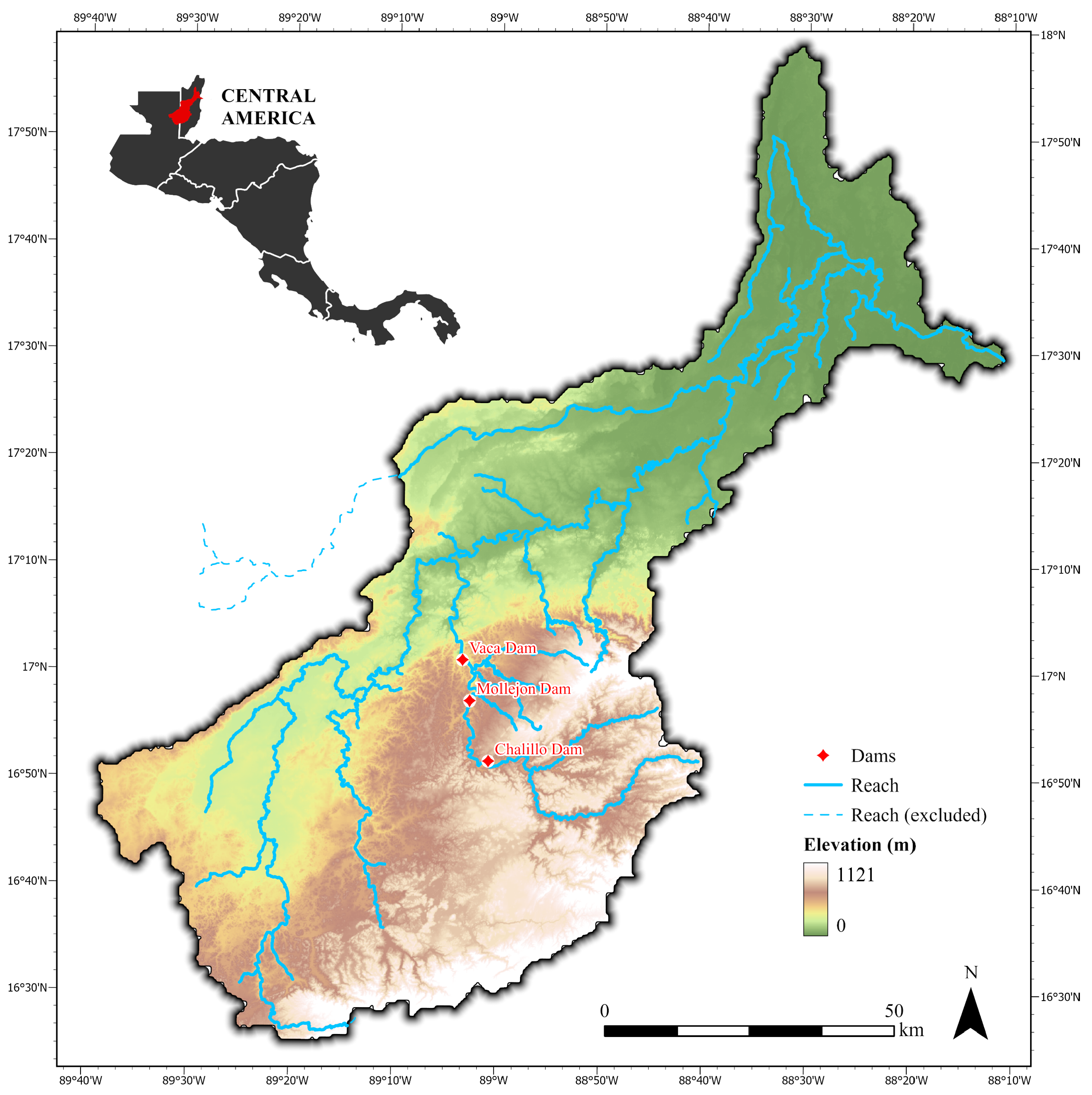
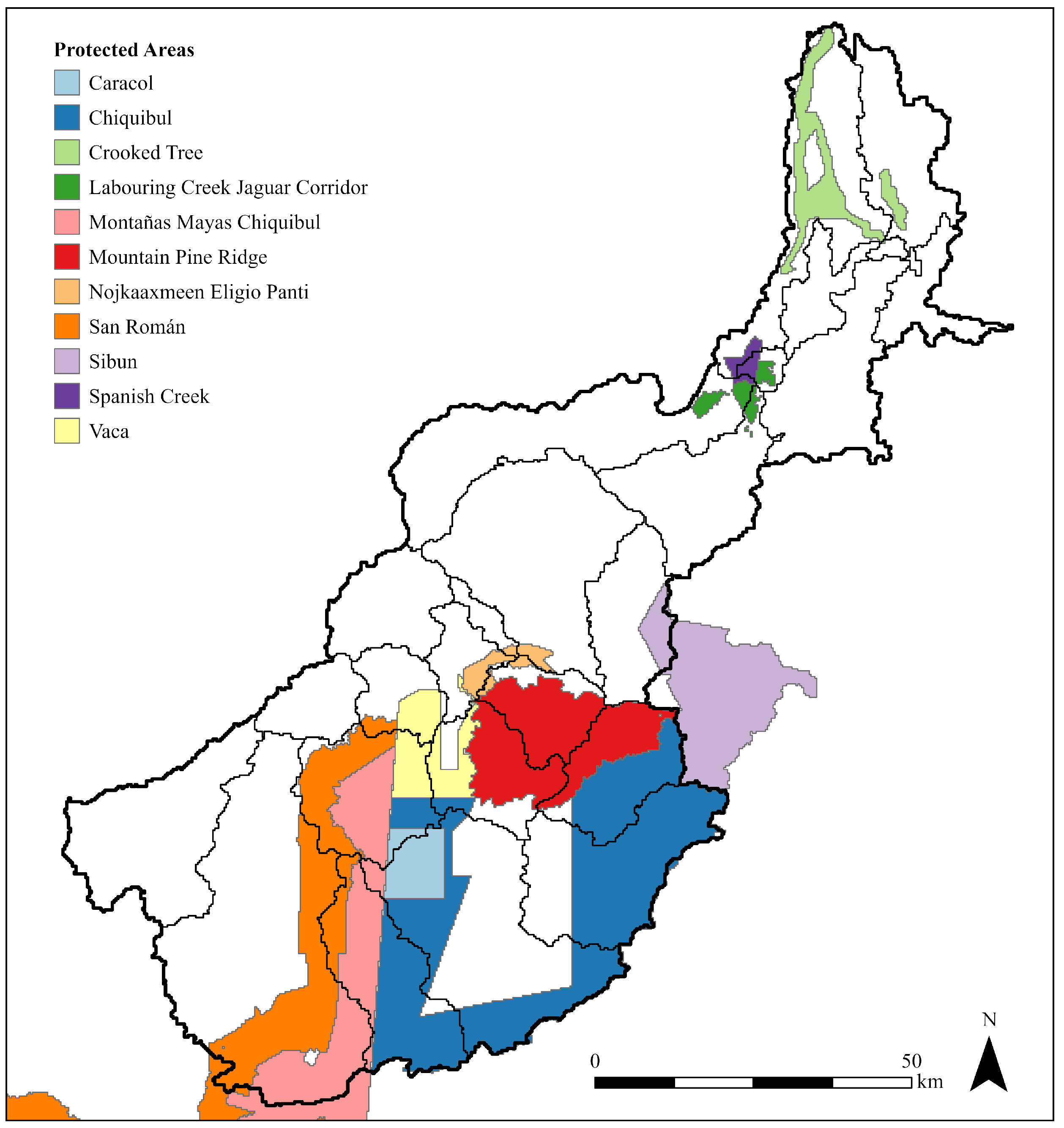
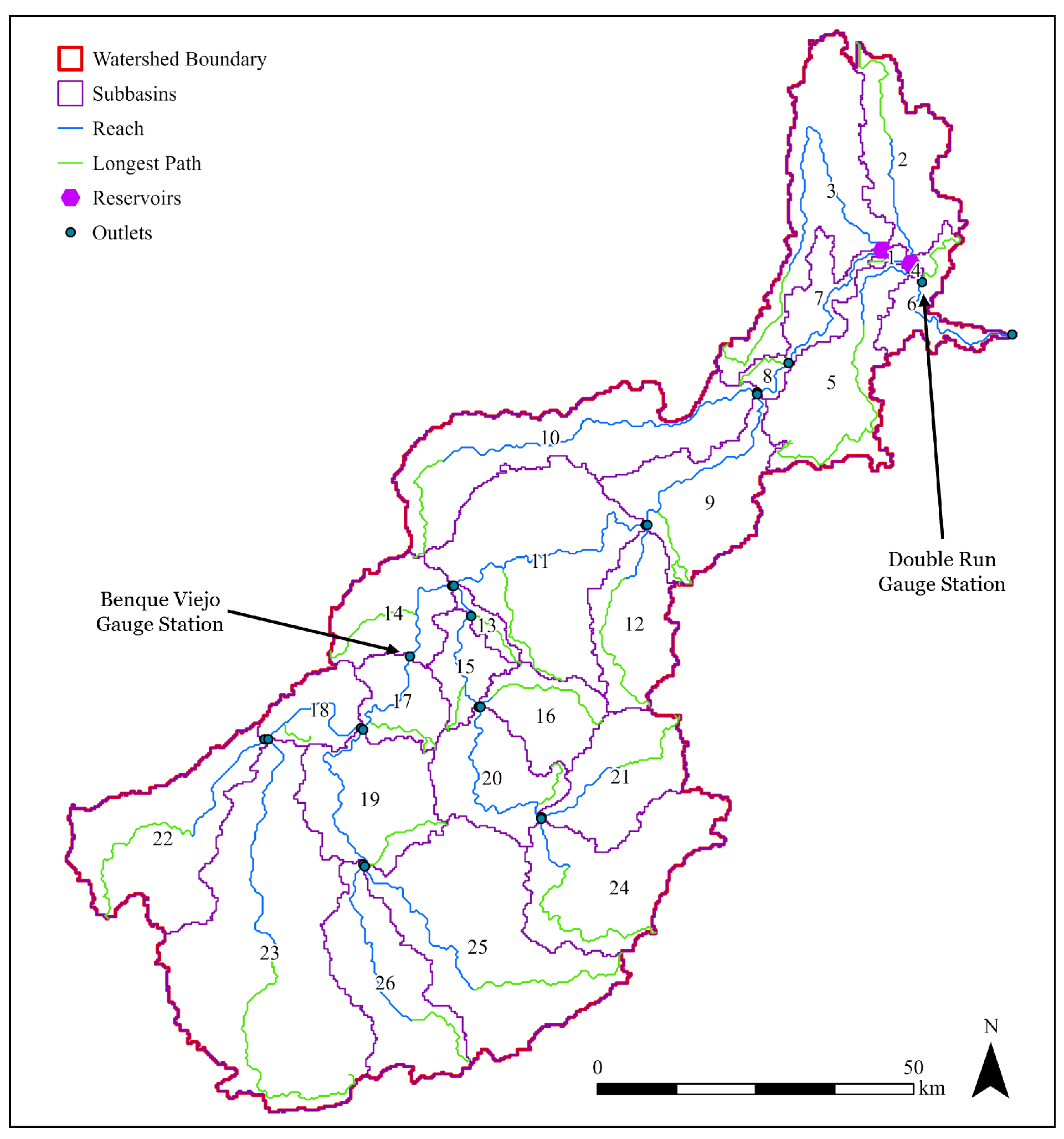
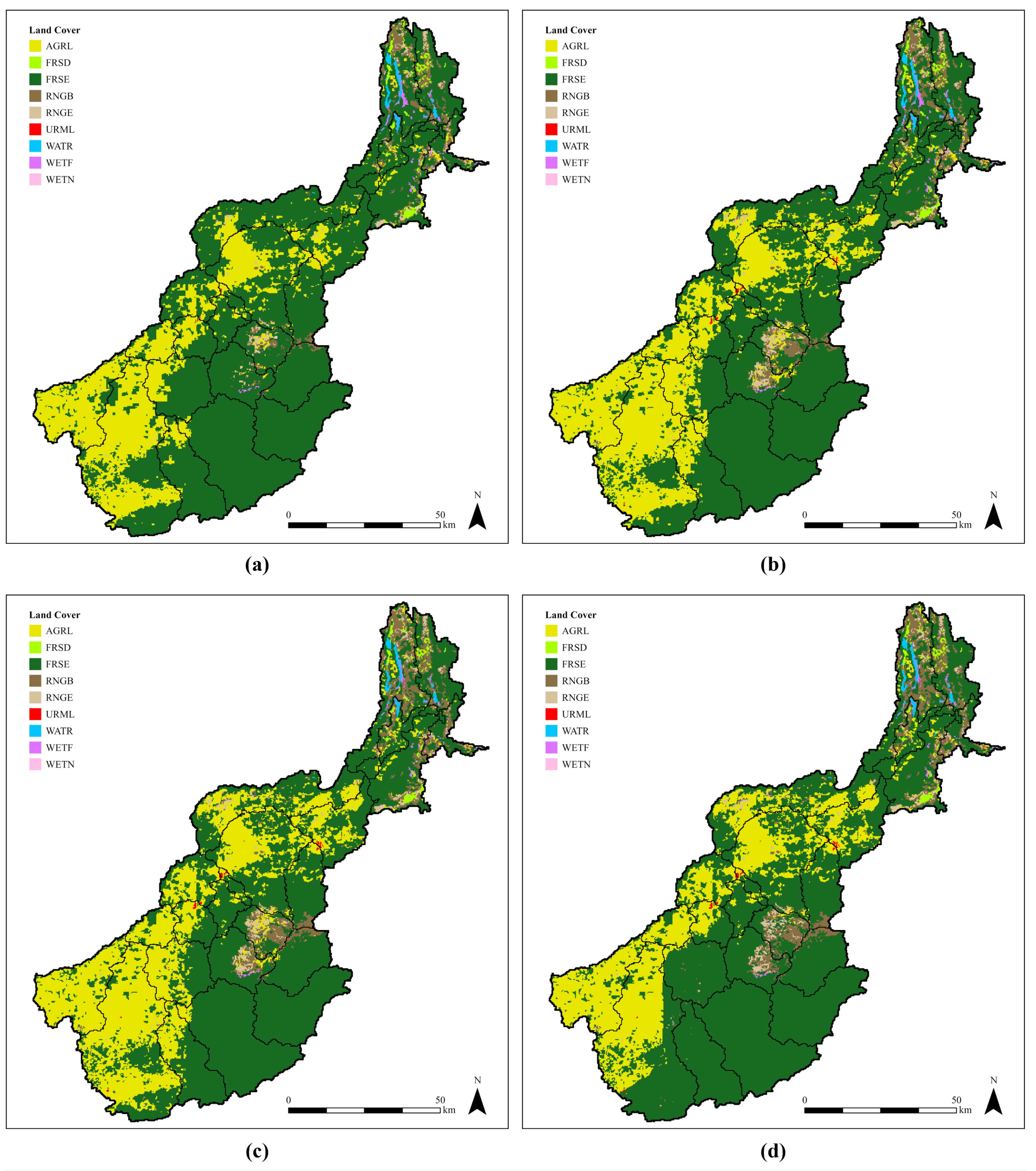

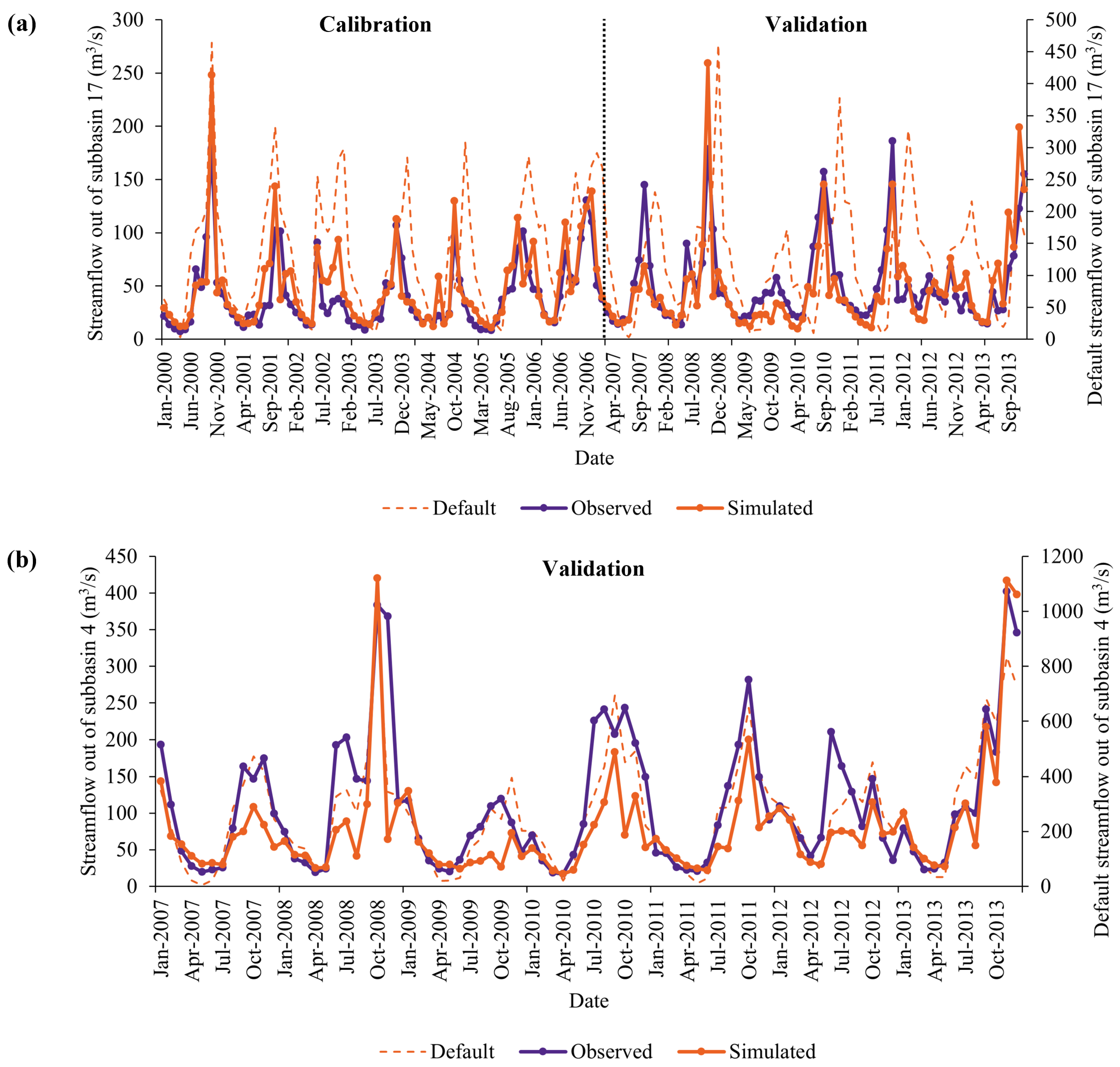
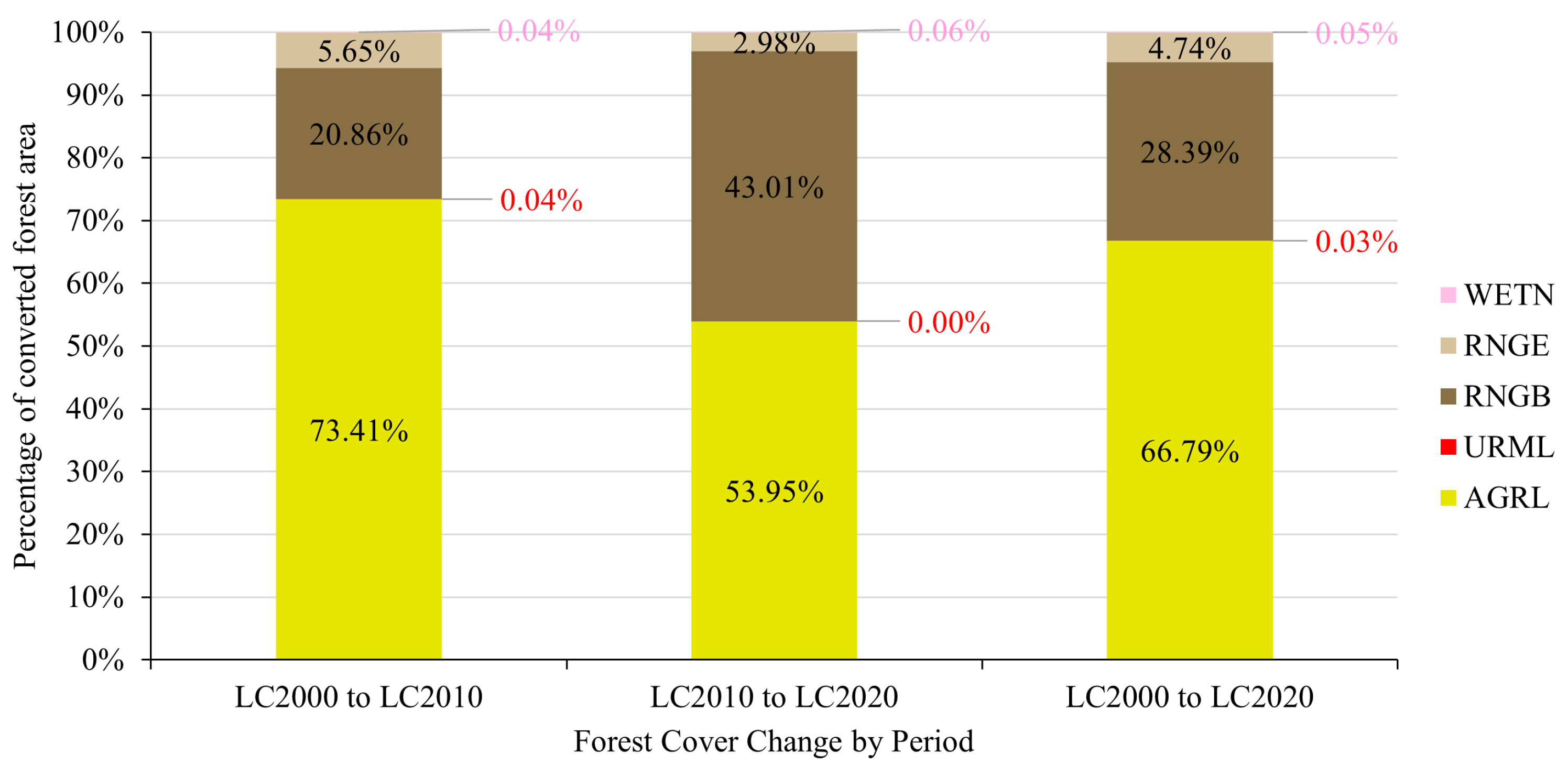
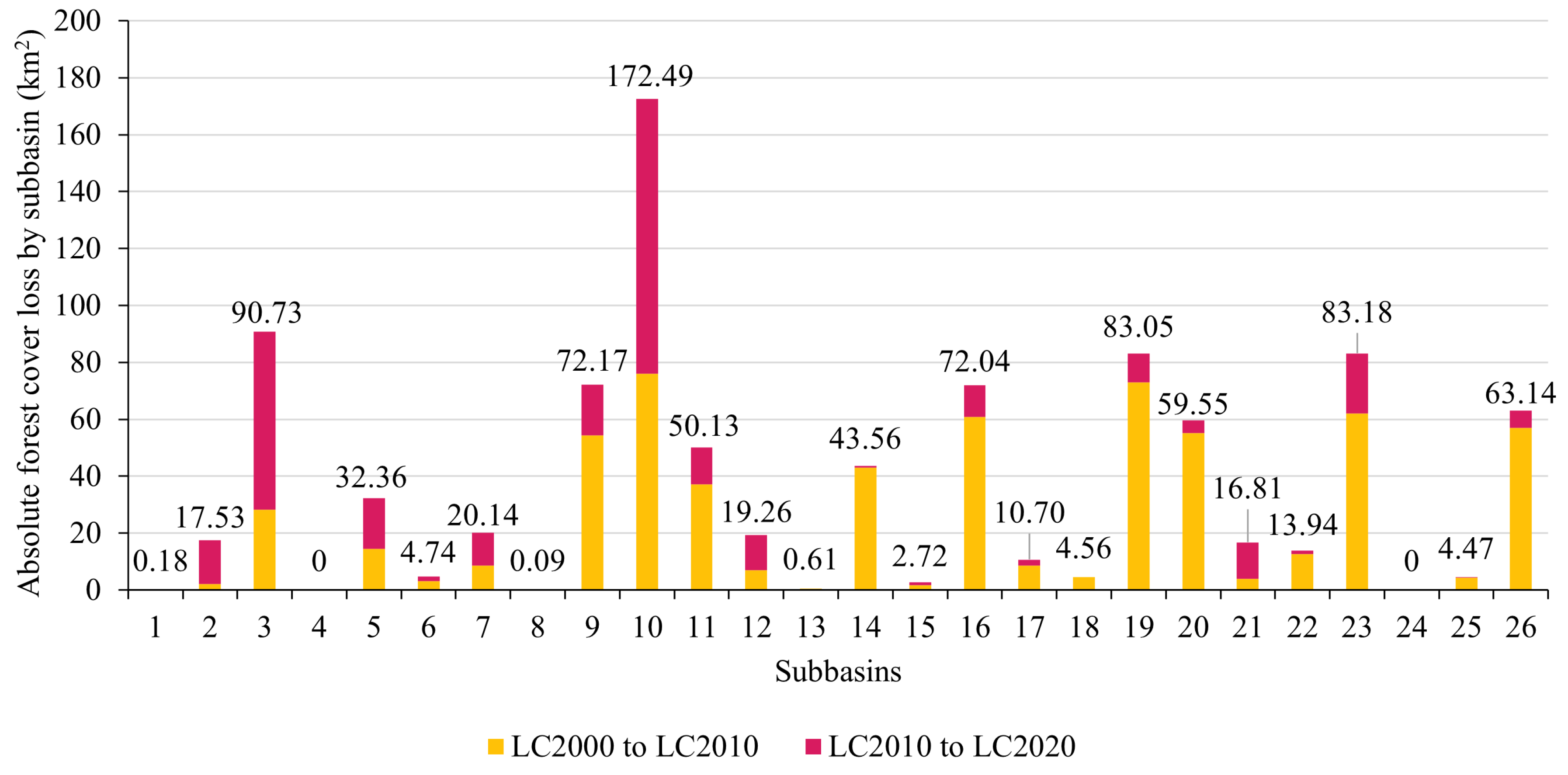
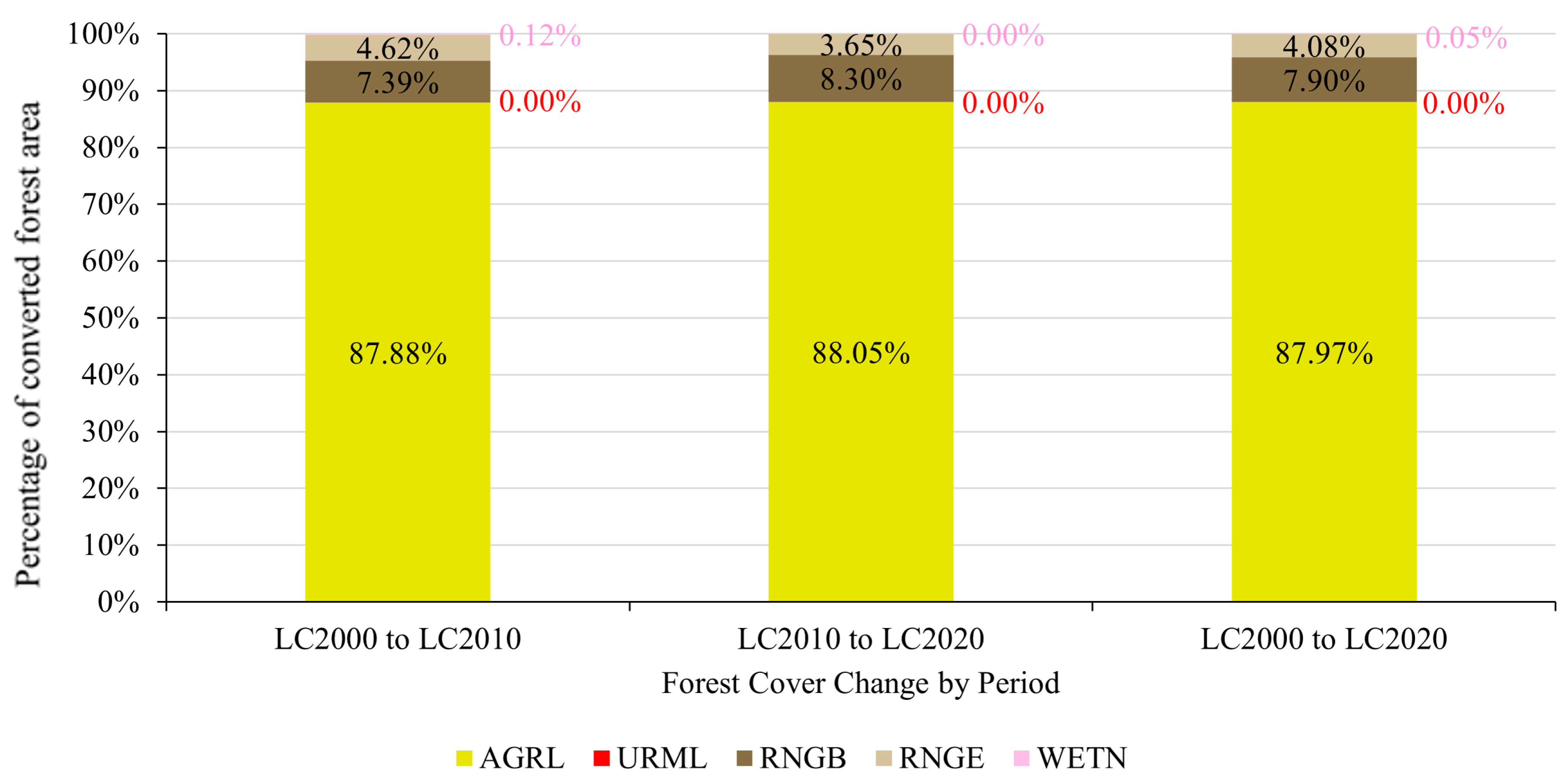
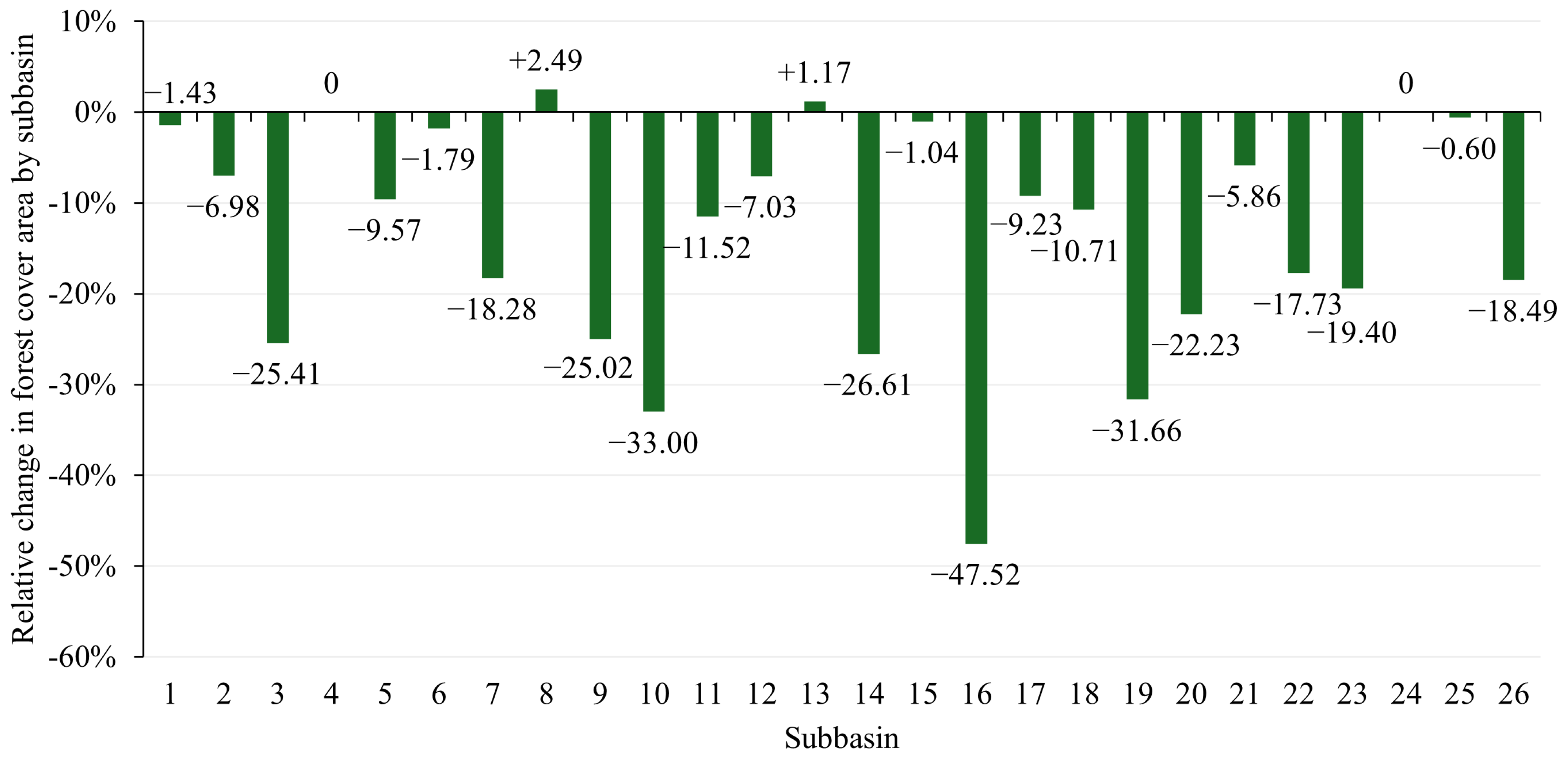
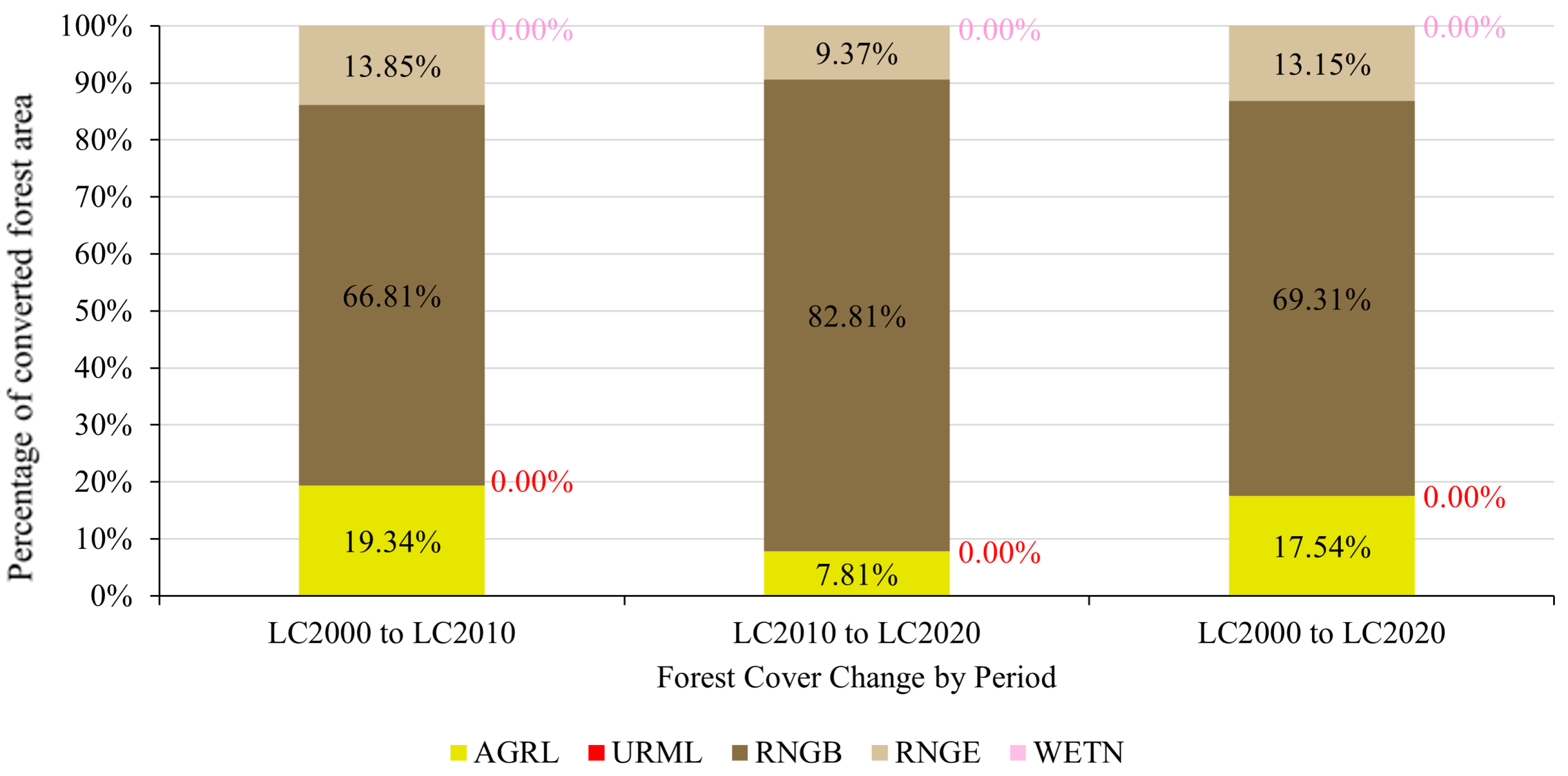
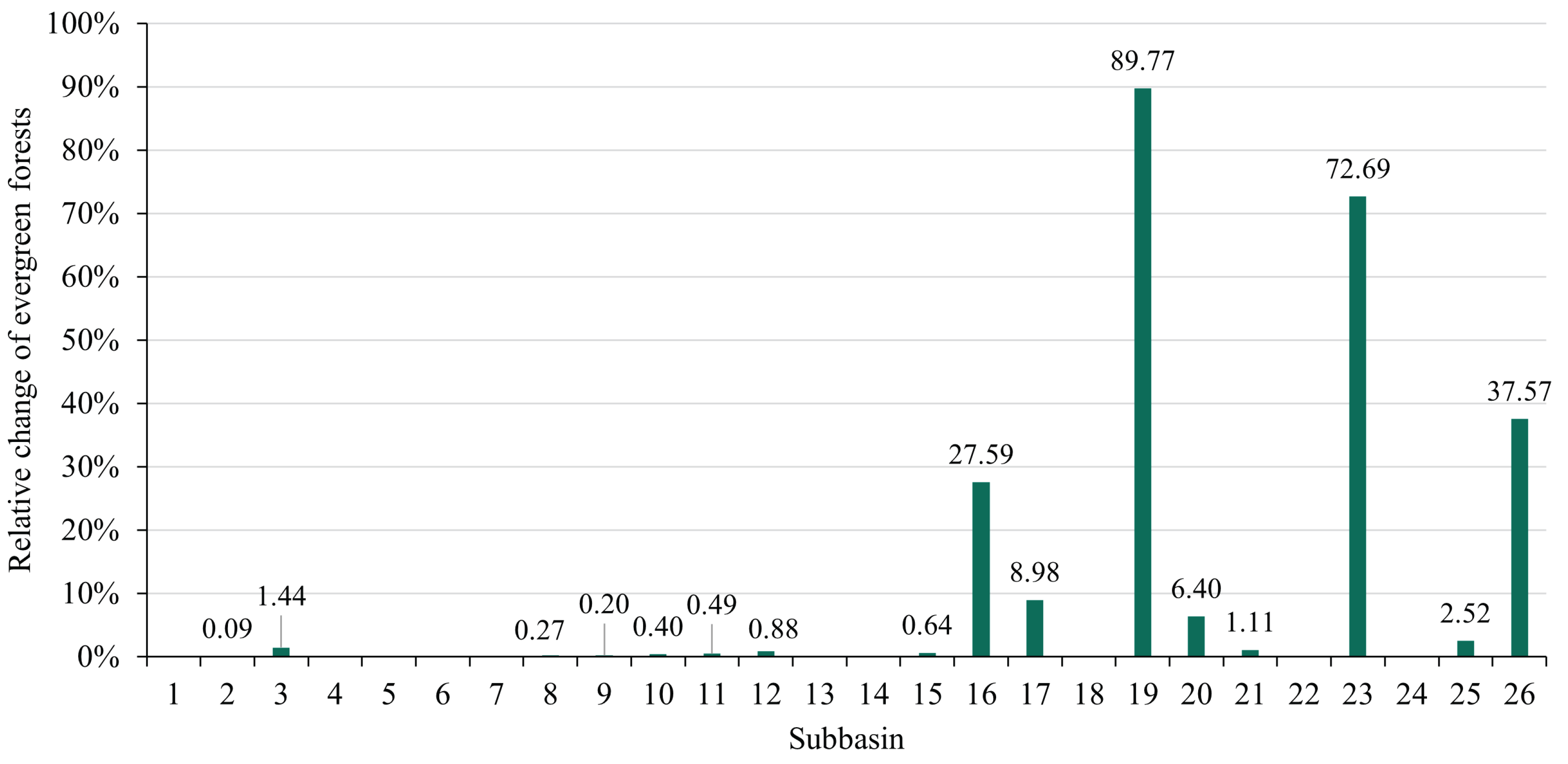
| Primary Class | HWSD Code | Type | Watershed Area |
|---|---|---|---|
| Cambisols | 13386 | CMv-CMe-LPk-VRe | 2.29% |
| 13387 | CMd-ACh-LPk-LVx | 13.37% | |
| 13389 | CMd-FRu-FRh-ACh | 2.90% | |
| 13392 | CMe-GLm-LPk-LVx | 17.40% | |
| 13395 | CMv-CMe-ACf | 6.41% | |
| 13397 | CMx-CMv-CMe-LPk | <0.01% | |
| 17016 | CMv-CMe-LPk-VRe | 0.32% | |
| 17017 | CMd-ACh-LPk-LVx | 5.40% | |
| 17019 | CMd-FRu-FRh-ACh | 1.42% | |
| 17037 | CMv-CMe-ACf-CMx | 1.88% | |
| 17039 | CMx-CMv-CMe-LPk | 11.06% | |
| 17040 | CMe-CMd-CMg | 0.05% | |
| 17041 | CMv-CMe | 9.13% | |
| Gleysols | 13388 | GLe | 253.44% |
| 13393 | GLe-PLe-HSs | 0.04% |
| New SWAT Classification | ESA CCI Classification | ESA CCI Index |
|---|---|---|
| Agricultural Land—Generic (AGRL) | Cropland, rainfed | 10 |
| Cropland, rainfed, herbaceous cover | 11 | |
| Cropland, rainfed, tree, or shrub cover | 12 | |
| Mosaic cropland (>50%)/natural vegetation (tree, shrub, herbaceous cover) (<50%) | 30 | |
| Mosaic natural vegetation (tree, shrub, herbaceous cover) (>50%)/cropland (<50%) | 40 | |
| Forest—Evergreen (FRSE) | Tree cover, broadleaved, evergreen, closed to open (>15%) | 50 |
| Tree cover, needleleaved, evergreen, closed to open (>15%) | 70 | |
| Tree cover, mixed leaf type (broadleaved and needleleaved) | 90 | |
| Forest—Deciduous (FRSD) | Tree cover, broadleaved, deciduous, closed to open (>15%) | 60 |
| Tree cover, needleleaved, deciduous, closed to open (>15%) | 80 | |
| Range—Bush (RNGB) | Mosaic tree and shrub (>50%)/herbaceous cover (<50%) | 100 |
| Shrubland | 120 | |
| Range—Grasses (RNGE) | Mosaic herbaceous cover (>50%)/tree and shrub (<50%) | 110 |
| Grassland | 130 | |
| Sparse vegetation (tree, shrub, herbaceous cover) (<15%) | 150 | |
| Wetlands—Forested (WETF) | Tree cover, flooded, fresh, or brackish water | 160 |
| Tree cover, flooded, saline water | 170 | |
| Wetlands—Non-Forested (WETN) | Shrub or herbaceous cover, flooded, fresh/saline/brackish water | 180 |
| Residential—Med/Low Density (URML) | Urban areas | 190 |
| Water (WATR) | Water bodies | 210 |
| Rating | |||
|---|---|---|---|
| Very good | 0.75 < ≤ 1.0 | 0.75 < ≤ 1.0 | < ±10 |
| Good | 0.65 < ≤ 0.75 | 0.65 < ≤ 0.75 | ±10 ≤ < ±15 |
| Satisfactory | 0.50 < ≤ 0.65 | 0.50 < ≤ 0.65 | ±15 ≤ < ±25 |
| Unsatisfactory | ≤ 0.50 | ≤ 0.50 | ≥ ±25 |
| Parameter | Definition | Process | Range | Default |
|---|---|---|---|---|
| GW_DELAY | Groundwater delay time | Groundwater | 31 | 0–500 |
| GWQMN | Threshold shallow aquifer depth for return flow occurrence | Groundwater | 1000 | 0–5000 |
| GW_REVAP | Groundwater re-evaporation (revap) coefficient | Groundwater; Evapotranspiration (ET) | 0.02 | 0.02–0.2 |
| REVAPMN | Threshold shallow aquifer depth for revap or deep aquifer percolation | Groundwater; ET | 750 | 0–1000 |
| RCHRG_DP | Deep aquifer percolation fraction | Groundwater | 0.05 | 0–1 |
| CANMX | Maximum canopy storage | ET | 0 | 0–10 |
| CN2 | Initial runoff curve number | Surface runoff | 25–92 1,2 | 35–98 |
| SOL_Z | Soil layer depth | Soil water | 300–1000 1 | 0–3500 |
| SOL_BD | Moist bulk density | Soil water | 1.22–1.65 1 | 0.9–2.5 |
| SOL_AWC | Available water capacity of soil | Soil water | 0.015–0.15 1 | 0–1 |
| SOL_K | Saturated hydraulic conductivity | Soil water | 0.6–210 1 | 0–2000 |
| Type of Change | Parameter | Minimum | Maximum |
|---|---|---|---|
| Replace 1 | GW_DELAY.gw | 0 | 500 |
| GWQMN.gw | 0 | 5000 | |
| GW_REVAP.gw | 0.02 | 0.2 | |
| REVAPMN.gw | 0 | 1000 | |
| RCHRG_DP.gw | 0 | 1 | |
| CANMX.hru | 0 | 100 | |
| Relative 2 | CN2.mgt | −0.5 | 0.07 |
| SOL_Z().sol | 0 | 1.5 | |
| SOL_BD().sol | −0.1 | 0.15 | |
| SOL_AWC().sol | −0.5 | 0.5 | |
| SOL_K().sol | −0.5 | −0.5 |
| Type of Change | Parameter | Minimum | Maximum | Fitted Value |
|---|---|---|---|---|
| Replace | GW_DELAY.gw | 126.866882 | 235.198151 | 159.6913 |
| GWQMN.gw | 1711.613525 | 3352.55542 | 2162.8726 | |
| GW_REVAP.gw | 0.148301 | 0.182767 | 0.1774 | |
| REVAPMN.gw | 601.774048 | 738.796509 | 674.2589 | |
| RCHRG_DP.gw | 0.118389 | 0.451293 | 0.2552 | |
| CANMX.hru | 70.779625 | 90.262688 | 81.281 | |
| Relative | CN2.mgt | −0.328869 | −0.202067 | −0.2374 |
| SOL_Z().sol | 0.83301 | 1.008222 | 0.9211 | |
| SOL_BD().sol | −0.005726 | 0.039196 | 0.0246 | |
| SOL_AWC().sol | 0.567389 | 0.861893 | 0.831 | |
| SOL_K().sol | −1 | −0.810555 | −0.9627 |
| Parameter | Rank | t-Stat | p-Value |
|---|---|---|---|
| SOL_K().sol | 1 | −25.19 | 0 |
| GW_REVAP.gw | 2 | 2.45 | 0.01 |
| REVAPMN.gw | 3 | −2.03 | 0.04 |
| RCHRG_DP.gw | 4 | −1.99 | 0.05 |
| CANMX.hru | 5 | 1.91 | 0.06 |
| SOL_BD().sol | 6 | −1.86 | 0.06 |
| CN2.mgt | 7 | 1.70 | 0.09 |
| SOL_AWC().sol | 8 | −1.57 | 0.12 |
| GW_DELAY.gw | 9 | 0.95 | 0.34 |
| GWQMN.gw | 10 | 0.91 | 0.36 |
| SOL_Z().sol | 11 | 0.07 | 0.95 |
| Belize River Watershed | Belize River Watershed | Langat River Watershed | Xixi Watershed | Bak Nong River Watershed | |
|---|---|---|---|---|---|
| Belize | Belize | Malaysia | China | Vietnam | |
| Parameters | Present Study | Astmann [29] | Khalid et al. [35] | Lin et al. [37] | Nguyen et al. [42] |
| SOL_K().sol | 1 | - | 9 | 5 | 4 |
| GW_REVAP.gw | 2 | 8 | 10 | 8 | 8 |
| REVAPMN.gw | 3 | 9 | 15 | - | 11 |
| RCHRG_DP.gw | 4 | 12 | 14 | 1 | 6 |
| CANMX.hru | 5 | - | - | - | - |
| SOL_BD().sol | 6 | - | 20 | - | - |
| CN2.mgt | 7 | 1 | 1 | 3 | 1 |
| SOL_AWC().sol | 8 | 5 | 5 | 2 | 10 |
| GW_DELAY.gw | 9 | 4 | 2 | 6 | 9 |
| GWQMN.gw | 10 | 2 | 21 | - | 7 |
| SOL_Z().sol | 11 | - | 18 | - | - |
| 2000 to 2006 | 2007 to 2013 | |||||
|---|---|---|---|---|---|---|
| Gauge Station | ||||||
| BV | Calibration | Validation | ||||
| (Sub-basin 17) | 0.74 | 0.59 | −17.96% | 0.66 | 0.58 | 7.32% |
| DR | Calibration | Validation | ||||
| (Sub-basin 4) | - | - | - | 0.63 | 0.51 | 27.85% |
| Scenario | Total Area (Forest Cover Change) | Watershed Portion (Relative Change) |
|---|---|---|
| LC2000 | 6240.60 km2 | 71.38% |
| LC2010 | 5621.67 km2 (−618.93 km2) | 64.30% (−9.92%) |
| LC2020 | 5302.44 km2 (−319.23 km2) | 60.65% (−5.68%) |
| Period Total | (−938.16 km2) | (−15.03%) |
| LC2020PA | 5906.97 km2 (+604.53 km2 *) | 67.5% (+11.40% *) |
| Country | Name | Status Year | Designation | Management Authority | % Reforested Area |
|---|---|---|---|---|---|
| Belize | Caracol | 1995 | Archaeological Reserve | National Institute of Culture and History | 8.36 |
| Chiquibul | 1991 | National Park | Forest Department/Friends for Conservation and Development | 0.22 | |
| Crooked Tree | 1984 | Wildlife Sanctuary | Forest Department/Belize Audubon Society | 2.50 | |
| Labouring Creek Jaguar Corridor | 2011 | Wildlife Sanctuary | Forest Department/ PANTHERA | 4.92 | |
| Mountain Pine Ridge | 1959 | Forest Reserve | Forest Department | 8.79 | |
| Nojkaaxmeen Eligio Panti | 2001 | National Park | Forest Department/Itzama Society | 4.02 | |
| Sibun | 1959 | Forest Reserve | Forest Department | 0.53 | |
| Spanish Creek | 2002 | Wildlife Sanctuary | Forest Department/Rancho Dolores Environmental Development Group | 0.38 | |
| Vaca | 1991 | Forest Reserve | Forest Department | 1.37 | |
| Guatemala | Montañas Mayas Chiquibul | 1995 | Biosphere Reserve | National Council for Protected Areas (CONAP) | 30.72 |
| San Román | 1995 | Biological Reserve | CONAP | 11.46 |
| (BRW) | Annual Land Cover | Alternative Land Cover | |||
|---|---|---|---|---|---|
| Component | LC2000 to LC2010 | LC2010 to LC2020 | LC2000 to LC2020 | LC2020 to LC2020PA | LC2000 to LC2020PA |
| Streamflow | +12.22% | +4.14% | +16.86% | −11.67% | +3.23% |
| Water Yield | +11.04% | +4.48% | +16.02% | −11.22% | +3.00% |
| Percolation | +1.76% | +1.61% | +3.40% | −0.77% | +2.60% |
| ET | −2.30% | −1.25% | −3.52% | +2.32% | −1.28% |
| Runoff | +18.28% | +5.64% | +24.95% | −18.66% | +1.63% |
| Baseflow | +5.35% | +5.91% | +11.58% | −2.47% | +8.82% |
| Sediment Yield | +27.65% | +5.29% | +34.40% | −45.18% | −26.32% |
| (Sub-Basin 10) | Annual Land Cover | ||
|---|---|---|---|
| Component | LC2000 to LC2010 | LC2010 to LC2020 | LC2000 to LC2020 |
| Water Yield | +28.88% | +28.58% | +65.70% |
| Percolation | +8.13% | +8.02% | +16.80% |
| ET | −4.10% | −5.48% | −9.36% |
| Runoff | +46.68% | +46.07% | +114.26% |
| Baseflow | +37.72% | +25.09% | +72.28% |
| Sediment Yield | +151.12% | +81.08% | +354.73% |
| (Sub-Basin 16) | Annual Land Cover | ||
|---|---|---|---|
| Component | LC2000 to LC2010 | LC2010 to LC2020 | LC2000 to LC2020 |
| Water Yield | +37.68% | +4.86% | +44.36% |
| Percolation | +2.75% | +0.63% | +3.40% |
| ET | −7.08% | −1.36% | −8.35% |
| Runoff | +55.07% | +6.15% | +64.61% |
| Baseflow | +158.48% | +13.06% | +192.25% |
| Sediment Yield | +417.23% | +23.32% | +537.84% |
| (Sub-Basin 19) | Alternative Land Cover | |
|---|---|---|
| Component | LC2020 to LC2020PA | LC2000 to LC2020PA |
| Water Yield | −59.39% | −40.20% |
| Percolation | −9.75% | −7.01% |
| ET | +17.74% | +7.93% |
| Runoff | −71.21% | −52.02% |
| Baseflow | −37.93% | −35.97% |
| Sediment Yield | −99.18% | −96.74% |
Disclaimer/Publisher’s Note: The statements, opinions and data contained in all publications are solely those of the individual author(s) and contributor(s) and not of MDPI and/or the editor(s). MDPI and/or the editor(s) disclaim responsibility for any injury to people or property resulting from any ideas, methods, instructions or products referred to in the content. |
© 2025 by the authors. Licensee MDPI, Basel, Switzerland. This article is an open access article distributed under the terms and conditions of the Creative Commons Attribution (CC BY) license (https://creativecommons.org/licenses/by/4.0/).
Share and Cite
Copeland, N.K.L.; Griffin, R.E.; Hernández Sandoval, B.E.; Cherrington, E.A.; Deval, C.; Hendy, T. Understanding Hydrological Responses to Land Use and Land Cover Change in the Belize River Watershed. Water 2025, 17, 1915. https://doi.org/10.3390/w17131915
Copeland NKL, Griffin RE, Hernández Sandoval BE, Cherrington EA, Deval C, Hendy T. Understanding Hydrological Responses to Land Use and Land Cover Change in the Belize River Watershed. Water. 2025; 17(13):1915. https://doi.org/10.3390/w17131915
Chicago/Turabian StyleCopeland, Nina K. L., Robert E. Griffin, Betzy E. Hernández Sandoval, Emil A. Cherrington, Chinmay Deval, and Tennielle Hendy. 2025. "Understanding Hydrological Responses to Land Use and Land Cover Change in the Belize River Watershed" Water 17, no. 13: 1915. https://doi.org/10.3390/w17131915
APA StyleCopeland, N. K. L., Griffin, R. E., Hernández Sandoval, B. E., Cherrington, E. A., Deval, C., & Hendy, T. (2025). Understanding Hydrological Responses to Land Use and Land Cover Change in the Belize River Watershed. Water, 17(13), 1915. https://doi.org/10.3390/w17131915









